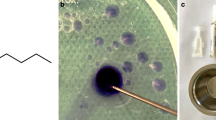Abstract
Background and Purpose
In the past years, technical developments have raised recanalization rates of endovascular treatments of intracerebral artery occlusions in acute ischemic stroke. By using stent retrievers, several prospective trials have reported recanalization rates up to 79 % as well as good neurological outcome in up to 58 % of the cases. The degree of the recanalization and the length of the procedure are factors known to influence the clinical outcome of patients treated endovascularly. Yet, still little is known about factors influencing the angiographic results of thrombectomy procedures. The purpose of this study was to investigate whether the use of intermediate catheters affects the angiographic results of thrombectomy procedures in basilar artery occlusions.
Materials and Methods
A total of 47 consecutive patients with acute basilar artery occlusions who underwent endovascular treatment with stent retrievers in our department were retrospectively identified. We analyzed the angiographic data regarding the use of intermediate catheters, the lengths of the procedures, the number of passes of the stent retrievers, the angiographic results, and the site of access to the basilar artery.
Results
Recanalization with modified thrombolysis in cerebral infarction (mTICI) ≥ 2b was achieved in 74.5 %. Intermediate catheters were used in 13 cases. The mean length of the procedures was significantly shorter when intermediate catheters were used (44.8 ± 27.6 vs. 70.7 ± 41.4 min, P = .043). There were no significant differences in the number of passes or in the final mTICI scores.
Conclusions
The use of intermediate catheters significantly reduces the length of mechanical thrombectomy procedures in acute basilar artery occlusions.
Similar content being viewed by others
References
Saver JL, Jahan R, Levy EI, Jovin TG, Baxter B, Nogueira RG, Clark W, Budzik R, Zaidat OO; SWIFT Trialists. Solitaire flow restoration device versus the Merci Retriever in patients with acute ischaemic stroke (SWIFT): a randomised, parallel-group, non-inferiority trial. The Lancet. 2012;380:1241–9.
Nogueira RG, Lutsep HL, Gupta R, Jovin TG, Albers GW, Walker GA, Liebeskind DS, Smith WS; TREVO 2 Trialists. Trevo versus Merci retrievers for thrombectomy revascularisation of large vessel occlusions in acute ischaemic stroke (TREVO 2): a randomised trial. Lancet. 2012;380:1231–40.
Jansen O, Macho JM, Killer-Oberpfalzer M, Liebeskind D, Wahlgren N; TREVO Study Group. Neurothrombectomy for the treatment of acute ischemic stroke: results from the TREVO Study. Cerebrovasc Dis. 2013;36:218–25.
Pereira VM, Gralla J, Davalos A, Bonafé A, Castaño C, Chapot R, Liebeskind DS, Nogueira RG, Arnold M, Sztajzel R, Liebig T, Goyal M, Besselmann M, Moreno A, Schroth G. Prospective, multicenter, single-arm study of mechanical thrombectomy using Solitaire Flow Restoration in acute ischemic stroke. Stroke. 2013;44:2802–7.
Möhlenbruch M, Stampfl S, Behrens L, Herweh C, Rohde S, Bendszus M, Hametner C, Nagel S, Ringleb PA, Pham M. Mechanical thrombectomy with stent retrievers in acute basilar artery occlusion. AJNR Am J Neuroradiol. 2014;35:959–64.
Hassan AE, Chaudhry SA, Miley JT, Khatri R, Hassan SA, Suri MF, Qureshi AI. Microcatheter to recanalization (procedure time) predicts outcomes in endovascular treatment in patients with acute ischemic stroke: when do we stop? AJNR Am J Neuroradiol. 2013;34:354–9.
Khatri P, Abruzzo T, Yeatts SD, Nichols C, Broderick JP, Tomsick TA; IMS I and II Investigators. Good clinical outcome after ischemic stroke with successful revascularization is time-dependent. Neurology. 2009;73:1066–72.
Hacke W, Zeumer H, Ferbert A, Brückmann H, del Zoppo GJ. Intra-arterial thrombolytic therapy improves outcome in patients with acute vertebrobasilar occlusive disease. Stroke. 1988;19:1216–22.
Brandt T, von Kummer R, Müller-Küppers M, Hacke W. Thrombolytic therapy of acute basilar artery occlusion. Variables affecting recanalization and outcome. Stroke. 1996;27:875–81.
Eckert B, Kucinski T, Pfeiffer G, Groden C, Zeumer H. Endovascular therapy of acute vertebrobasilar occlusion: early treatment onset as the most important factor. Cerebrovasc Dis. 2002;14:42–50.
Tomsick T, Broderick J, Carrozella J, Khatri P, Hill M, Palesch Y, Khoury J; Interventional Management of Stroke II Investigators. Revascularization results in the Interventional Management of Stroke II trial. AJNR Am J Neuroradiol. 2008;29:582–87.
Mattle HP, Arnold M, Lindsberg PJ, Schonewille WJ, Schroth G. Basilar artery occlusion. Lancet Neurol. 2011;10:1002–14.
Schulte-Altedorneburg G, Hamann GF, Mull M, Kühne D, Liebetrau M, Weber W, Brückmann H, Mayer TE. Outcome of acute vertebrobasilar occlusions treated with intra-arterial fibrinolysis in 180 patients. AJNR Am J Neuroradiol. 2006;27:2042–7.
Mourand I, Machi P, Milhaud D, Picot MC, Lobotesis K, Arquizan C, Costalat V, Héroum C, Sablot D, Bouly S, Lalu T, Bonafé A. Mechanical thrombectomy with the Solitaire device in acute basilar artery occlusion. J Neurointerv Surg. 2014;6:200–4.
Espinosa de Rueda M, Parrilla G, Zamarro J, García-Villalba B, Hernández F, Moreno A. Treatment of acute vertebrobasilar occlusion using thrombectomy with stent retrievers: initial experience with 18 patients. AJNR Am J Neuroradiol. 2013;34:1044–8.
Mordasini P, Brekenfeld C, Byrne JV, Fischer U, Arnold M, Heldner MR, Lüdi R, Mattle HP, Schroth G, Gralla J. Technical feasibility and application of mechanical thrombectomy with the Solitaire FR Revascularization Device in acute basilar artery occlusion. AJNR Am J Neuroradiol. 2013;34:159–63.
Bar M, Mikulik R, Jonszta T, Krajina A, Roubec M, Skoloudik D, Prochazka V. Diagnosis of recanalization of the intracranial artery has poor inter-rater reliability. AJNR Am J Neuroradiol. 2012;33:972–4.
Conflict of Interest
We declare that we have no conflict of interest.
Author information
Authors and Affiliations
Corresponding author
Additional information
Presentations
The abstract has been presented as an oral presentation at the 20th Symposium Neuroradiologicum (September 7–12, 2014, Istanbul).
Presentations
The abstract has been presented as an oral presentation at the 20th Symposium Neuroradiologicum (September 7–12, 2014, Istanbul).
Rights and permissions
About this article
Cite this article
Mühl-Benninghaus, R., Körner, H., Simgen, A. et al. Intermediate Catheters Reduce the Length of Mechanical Thrombectomy Procedures in Acute Basilar Artery Occlusions. Clin Neuroradiol 26, 325–328 (2016). https://doi.org/10.1007/s00062-014-0368-5
Received:
Accepted:
Published:
Issue Date:
DOI: https://doi.org/10.1007/s00062-014-0368-5




